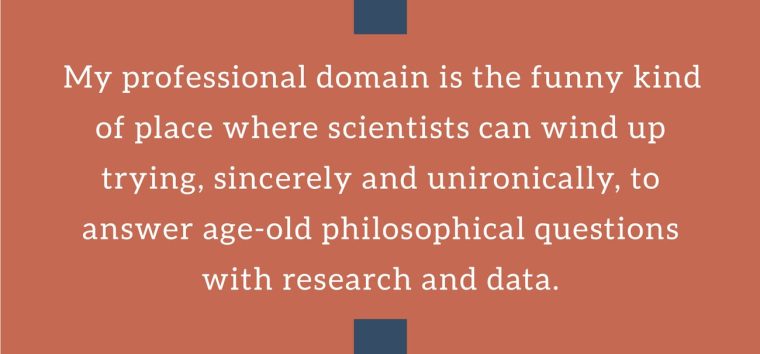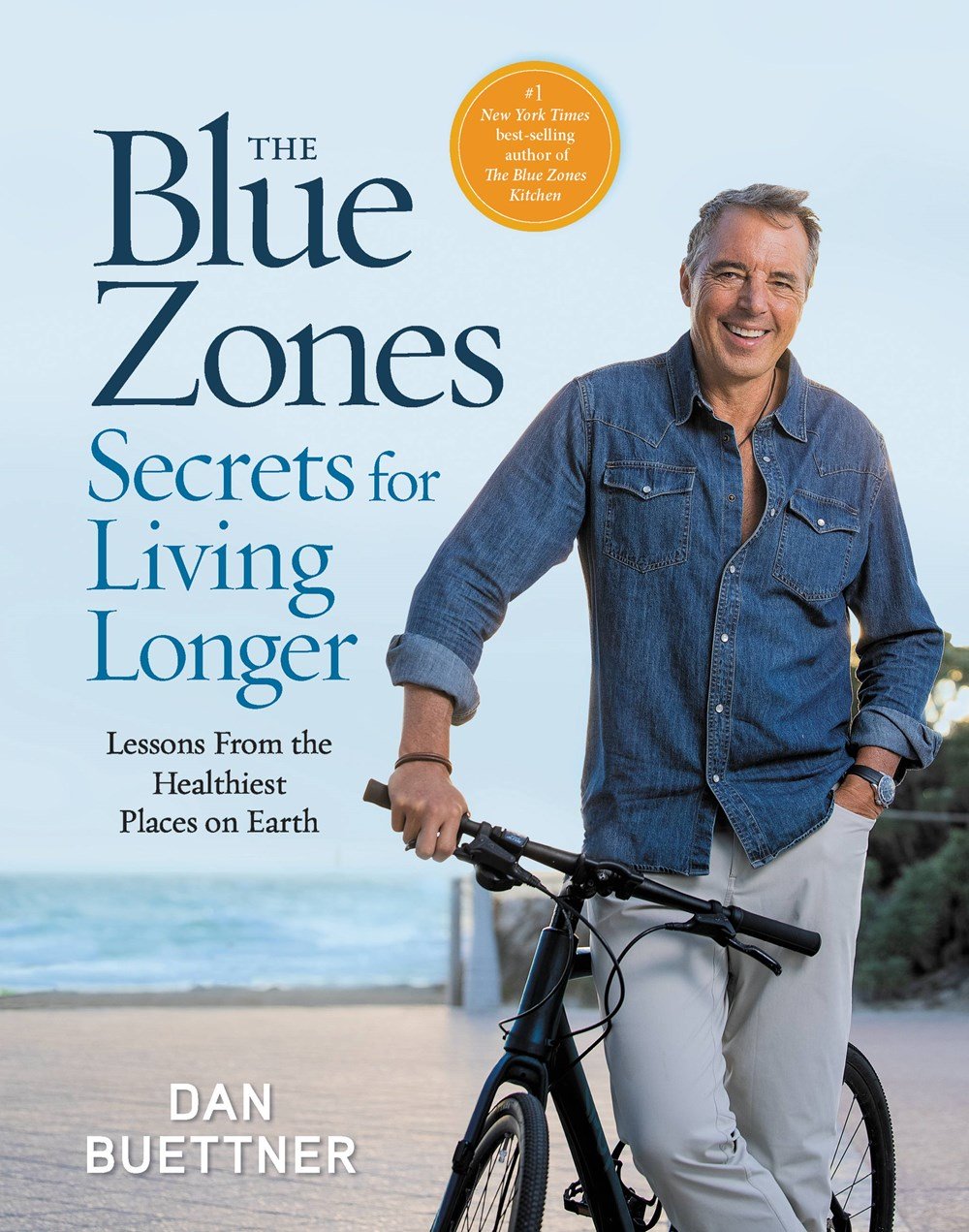I’m a journalist, not a philosopher. I place most of my trust in facts.
Having said that, I work in a peculiar sort of field where philosophical questions are pretty much inescapable. You can’t study the world’s happiest and longest-lived people (for 20+ years like I have) without pondering what happiness really is, or what really makes for a good life.
I don’t just mean that these questions are bound to float in your mind. I also mean that, pragmatically speaking, you can’t even begin to conduct research on happiness until you find a way of defining and measuring it. Such is the scientific method.
All of this is to say that…

I might be biased, but all things considered, I think my colleagues are doing a better job than most of the philosophers. ?
Still, our close proximity to philosophical woo-woo does introduce, shall we say, a minor question of credibility. By now, the topic of happiness is equally the domain of science and philosophy—but most people trust scientists a lot more than they trust philosophers, and they can’t always tell us apart. ?
To rephrase something I said in the introduction to Edition 14: I don’t want to be mistaken for a philosopher. Among other things, this means that I don’t want my information to seem like “musings” just because it concerns a topic historically reserved for philosophical discussion. It also means that I don’t ever want the short-take format or bottom-line focus of my online content to give the impression that I’m exaggerating, cherry-picking, or otherwise bastardizing the facts.
We live in cynical times, so much so that anyone talking seriously about the pursuit of happiness (like I do) is probably inviting extra skepticism. The promise of achievable happiness might feel too good to be true, especially when the information is free. I don’t blame you if you’ve ever thought those thoughts because, as bitter as they can sound, the skeptical voices in our heads are ultimately trying to protect us from things that could hurt us—from abuse by others, yes, but also from the kinds of disappointment we can only bring on ourselves.
So, in today’s first section, I’ll discuss the findings of scientific research on happiness—but I’ll start a little ways back so that I can first explain how that research works. This way, you can “see its brain” and understand more fully how you can trust what it has to tell you.

I’ve said before that happiness is a “spongy” topic, and I mean (A) that a person’s happiness can change pretty quickly and (B) that happiness is an imprecise word whose exact meaning will vary from person to person.
Scientists realized early on that they’d have to do something about this semantic tangle before they could conduct research on happiness. They would have to define happiness in a measurable way, and they would have to find the words to ask specific questions that everyone would understand equally.
Fortunately, they realized that everyone experiences different “aspects” or “forms” of happiness and that all of them matter, even if we don’t have common vocabulary to distinguish them. Different studies model “happiness” and its component parts in different ways, but I’ll share my favorite.
In this model, there are three kinds of happiness:
- Day-to-Day Emotions. This is the quick-acting, short-lasting kind of happiness, the one that’s most synonymous with “joy.” Researchers tend to ask about all sorts of emotional states—for instance, how much you’ve felt sad or glad or grateful or stressed over a recent period of time—but all with the goal of determining how positive or negative your day-to-day experience is.
- Life Satisfaction. This is the bigger-picture, slower-burning, more durable kind of happiness that comes from feeling good about your life as a whole. Some people experience a lot of day-to-day hardships and some people don’t have the sunniest dispositions… and yet they can still feel very good about their lives overall. They can be proud of who they’ve become and what they’ve built in the time that’s been given to them.
- Sense of Purpose. Also big-picture but a little more elusive, this is the kind of happiness we get from using our skills and talents, especially when it’s in service to something larger than ourselves. It’s important to feel like we’ve made some kind of positive difference in the world, and again, this can be measured independently from our day-to-day emotions and life satisfaction. (Creatives like Vincent Van Gogh and Frédéric Chopin come to mind. Their lives were short, tragic, and filled with bad days, but they truly came alive when exercising their talents—and to their credit, we still celebrate their work hundreds of years later.)
These three kinds of happiness are measured separately, but they weave together like the strands of a rope to form capital-H Happiness as we’ve known it (the semantically tangled philosophical concept). Another way of thinking about it is that the three types of happiness above are like three overlapping circles in a Venn diagram, with capital-H Happiness at their intersecting center.
Having defined the terms better, let’s talk about data collection and analysis. Here’s how the research works in four simplified steps:
- Researchers identify the population(s) they want to study and, in many cases, they adjust their standardized set of questions to better fit that population (semantic confusions are linguistic and cultural, not just philosophical). Still, the questions are almost always designed to collect quantitative data; think “scale of 1 to 10” and “how many times” and so on.
- Researchers will regularly survey that population over a period of time (could be months, years, or even decades). They will, in other words, ask the same questions of the same people at different times—and this allows researchers to measure each kind of happiness for each person and track all of them over time (longitudinal data).
- Aside from asking subjects the questions that pinpoint their levels of happiness, researchers also ask questions about what’s going on in their lives. What they’ll ask depends on the research, but the areas of questioning could include theoretically anything—diet, family, social life, work life, you name it.
- By collecting longitudinal data for both happiness levels and countless other factors, scientists are able to identify correlations. In other words, they’re able to see what the happiest people tend to have in common—and these sorts of conclusions become surer and surer as the researchers collect more data.
Again, that’s a simplified explanation, but I’ll still add two important clarifications:
- True, there’s a certain amount of bias and human error that can’t be avoided with surveys and questionnaires… but the nice thing about big mountains of data is that they tend to “balance” themselves in a few ways. One person’s understatement cancels out another person’s hyperbole, an error in one direction cancels out an error in the other direction, and so on (think Law of Large Numbers).
- Five important words you’ve probably heard before: correlation does not equal causation. Researchers here are drawing correlative conclusions, not causal conclusions; they can prove that A and B go together, but not that A always (or necessarily) causes B to happen. So there are no absolute guarantees here—and alas, happiness is the kind of variable where it’s extremely difficult to establish causal relationships under experimental conditions—but having said that, strong correlations are still “clues” which you’d be unwise to ignore, especially when there are mountains of data to support them.
So that’s the nutshell version of How Happiness Research Works! But a big, obvious, and important question still remains…
What correlations has that research found? In other words: what do the happiest people tend to have in common, according to data and statistical analysis?
I said before that the three types of happiness fit together like a Venn diagram. In a similar vein, the factors which correlate most strongly with happiness can fit into one, two, or all three of those circles. In other words, some factors seem to correlate with a single type of happiness, and other factors seem to correlate with multiple types of happiness.
Starting off easy, with the simple one-off correlations:
Correlated with Positive Day-to-Day Emotions:
- Getting at least 7 hours of sleep nightly
- Maximizing your vacation time
- Having access to nature (even if you’re not the outdoorsy type)
Correlated with High Life Satisfaction:
- Working full-time
- Achieving financial security
- Making the equivalent of $75K per year (as you’ve probably heard, happiness doesn’t really increase beyond that point)
Correlated with Secure Sense of Purpose:
- Knowing your internal inventory (your values, strengths, and passions)
- Putting that internal inventory to work consistently
- Caring for other people
Now the factors that boost TWO types of happiness:
Positive Daily Emotions ✚ High Life Satisfaction
- Having sex twice weekly, give or take
- Trying new things consistently
Positive Daily Emotions ✚ Secure in Purpose
- Meditating and/or praying on a regular basis
- Doing volunteer work of your choice
High Life Satisfaction ✚ Secure in Purpose
- Nurturing your faith, if applicable
- Achieving a college level of education
- Raising children
And finally we arrive at the golden five! These factors correlate with high levels of ALL THREE types of happiness:
- Working the Right Job. If your job is something you enjoy, something that makes use of your skills and talents, and something that affords you financial security, you’re almost certainly going to be happier.
- Active Social Life. Ideally, the average person would have about 7 hours of face-to-face interactions per day. You can get those hours in a variety of ways, but one of the most helpful is to make friends at work.
- Owning a Dog. Sorry, cat owners, but… dog people are happier. Pets do make us happier in general, but there’s a reason canines are humans’ best friends.
- Having a Love Life. This doesn’t require you to be married, but people are three times as likely to be happy if they’re married (and it lasts for at least 10 years).
- Living in the Right Home. One of the major themes of my work is the importance of place—how local and environmental conditions affect us and how they can nudge us in healthy directions—and it stands to reason that the most important place for a person’s health and happiness is, of course, their home.
Out of those five major factors, #5 is the most important; it has the single biggest effect on your happiness. It’s also the most variable; what counts as “the Right Home” varies from person to person, and it’s basically a crapshoot whether a given person will be satisfied with where they live. Unfortunately too, it’s one of the hardest things to change, as anyone who has ever moved can testify.
Still, because “living in the right home” is such a big factor in one’s overall happiness, I’ll pick up next time with more suggestions on how to increase your happiness levels, all within a couple miles of where you live (no matter where you live).
In closing for now: I think I’ve shown that what I know about happiness is much closer to science than it is to philosophy. Still, to the extent that philosophical questions are unavoidable, just remember that philosophy means “love of wisdom” and wisdom is the ability to cope. Science sustains our bodies, but wisdom sustains our minds and spirits; as I said a few editions ago, living to 100 requires you to have the heart for it, both literally and figuratively.
So don’t be afraid to open your mind to big questions and big answers… they really can help you to live a happier life!
BY THE WAY: I spoke on this topic in 2018 at the annual meeting of the World Economic Forum in Davos, Switzerland; you can watch the whole talk here. I might as well mention, too, that speaking is one of my favorite ways to share the wealth—so if you’d like me to come talk to your company or organization, feel free to drop me a line here.

Last time in Pantry Powerhouse, I talked about the general nutritional importance of fat. I want to continue that discussion, but this time as a Lesson in Longevity—because this time is less about the ingredients and more about the cooking methods.
In other words: today we’re doing a quick 101 lesson on the science of frying things, i.e. cooking them with fat.
Let me be clear: fried foods will pretty much ALWAYS be less healthy than their raw, whole counterparts. This is by no means a wholesale endorsement of fried foods—because even the cleanest, healthiest plant-based ingredients can do you harm if you’re frying them in excess. Rather, this article is intended as a matter-of-fact discussion of what frying does to food and how it does it.
Today’s big question:

If you’ve browsed my cookbooks—or a lot of others, including the expressly healthy ones—you’ll notice that the directions still include frying sometimes. This article will help resolve any apparent contradictions between “health focus” and “frying things sometimes.”
Only after answering the question above can we begin to understand (A) why fried foods are here to stay, (B) why a lot of them are really unhealthy, and (C) where there’s room for compromise between good nutrition and good eating.
As I already said, the essential definition of frying is “cooking in fat.” But as we know, there are numerous different ways of frying things, so to quickly review three of the most common frying methods…
- Browning means cooking something, almost always meat, in its own fat. So if you’re browning 80/20 ground beef (or its vegan equivalent), the 20% that’s fat will render and cook the other 80%.
- Deep frying means that you’re completely immersing the food in fat. The classic example of deep frying would be french fries down into the hot oil, with the wire basket and everything.
- Sautéing basically means pan-frying something over high heat without much fat. The term comes from the French word for “jump,” so it refers specifically to the method where the cook will toss the food upwards and catch it in the pan again (often with a flash of flame from any oil caught in the air). This helps the food to cook evenly without burning, and it allows the cook to fry the outsides of things without soaking their interiors.
And there are still many other methods of frying things! The latest is air frying, which (I’m told) yields impressively tasty results with a minimum of fat.
But let’s back up. We often think of frying as a particularly American way of cooking, but we’re far from the first or last to fry our foods—and if you asked most chefs (American or otherwise) how they’d run a restaurant kitchen without frying anything, their answer would be to laugh in your face.
As I mentioned last time, there’s a reason fat is included in the title of Samin Nosrat’s seminal cookbook Salt Fat Acid Heat. In her own words from the Introduction (emphasis mine):
“There are only four basic factors that determine how good your food will taste: salt, which enhances flavor; fat, which amplifies flavor and makes appealing textures possible; acid, which brightens and balances; and heat, which ultimately determines the texture of food.”
So there you have it: fat’s two big roles in cooking are (A) to amplify flavor and (B) to make appealing textures possible. I’ll explain why fat plays each of those roles well, starting with the scientific root they have in common…
The core functional reason for fat’s usefulness in the kitchen is that it can hold and transfer a LOT more heat than water or air. This is important because, to paraphrase another brilliant chef, cooking is chemistry—and a lot of chefs’ favorite chemical reactions require not only the right reactants (ingredients), but also the right amounts of heat.
From a cook’s point of view, fat is often the only way to get things hot enough, fast enough. Sure, you can get air really hot in an oven, but radiation and convection are slow, inefficient ways of transferring heat. Water has the exact opposite problem: it transfers heat a lot faster than air, but the highest temperature it can possibly reach is 212F and that’s practically chilly compared to the smoke point (i.e. maximum recommended temperature) of a typical cooking oil, which might be around 450F.
How does fat’s heat-friendliness help it to (A) amplify flavor? I’ll answer by way of one big example…
The Maillard reaction is responsible for the golden-brown color (and associated flavors) we all know and love from fried foods. In essence, the Maillard reaction simplifies the food for us; it denatures proteins, softens fibers, gelatinizes starches, and breaks complex carbohydrates down into sugars. This is why French fries and caramelized onions literally taste sweeter than their raw, baked, and boiled counterparts.
The catch: the Maillard reaction only happens if you can sustain the temperature between 280F and 330F. You don’t necessarily need fats to do this—as two examples, you can roast coffee or caramelize onions without using any fat at all—but it’s often easier, faster, and tastier for a cook to create these kinds of reactions by using fat.
Hence, Anthony Bourdain’s confession (via his infamous 1999 exposé Don’t Eat Before Reading This) that chefs absolutely love butter—so much so that, when you go out to dinner, you might eat an entire stick of butter without realizing it.
And we haven’t even touched fat’s ability to create “appealing textures” in food yet! So let’s talk about that second culinary role…
How does fat’s heat-friendliness help it to (B) make appealing textures possible?
There’s something else that’s cool about the way fat manages heat. Fat doesn’t just hold a lot of heat and transfer that heat quickly; it also helps to buffer between objects of different temperatures.
Let’s say you get a steel frying pan really hot. It’ll be much hotter than boiling water (400-500F) and, unlike air, the steel can transfer that heat pretty dang fast. But as a lot of home cooks know, the reactions you get on hot dry steel don’t make for the tastiest food.
Without a buffer like water or fat, most ingredients in direct contact with hot steel start to stick (like your tongue to a frozen pole, except the temperatures are reversed) and then, because they can’t release their own water or fat fast enough to unstick themselves, whatever’s sticking starts to burn and you have an acrid mess on your hands.
It’s not much of a stretch to say that fat is “slippery” even at the molecular level, enough that a thin layer of it between objects helps to prevent this from happening.
So how does this help create appealing textures?
Well, let’s get a little more specific about “appealing textures.” Our favorite texture in fried foods is, in a word, crispiness—and if you think about it, it’s a tricky balancing act to create crispy textures.
Crispiness is somewhere between toughness on one extreme (think beef jerky) and softness on the other (think boiled potatoes) without totally resembling either one. Crispy foods can have soft interiors or they can be brittle and rigid all the way through, but they can’t be too hard or soft; they should be solid to the touch while still yielding to every bite. Ideally, too, crispy fried foods should be lightweight and finger-friendly, no matter how dense or tough the original raw ingredients.
You can’t do that with water or dry steel, and it’s really hard to do that (as well) with just air. So why is fat so good for creating textures like crispiness?
The main reason is that frying ingredients pushes the water out of them and, to varying degrees, replaces it with fat. This explains, first of all, why fried foods (especially deep-fried foods) can contain so much fat and, by extension, so many calories. But carrying on with the science…
We all know that oil and water don’t like each other (especially not when the oil is hot), and we’re most familiar with the fast and scary consequences of this relationship—like the way water can spread grease fires, or the way wet ingredients can cause deep fryers to boil over. But this “animosity” between fat and water also plays out in small ways throughout the frying pan, and fat’s eventual victory over water during frying is a lot of what explains the textures of fried food.
This is not to say that water is bad for texture; just think of how many appealing textures you can find in the Produce section alone. At the same time, water does contribute to many of the less popular textures (such as chewiness and mushiness), and frying tends to create more popular textures from the same ingredients.
By pushing the water out and replacing it with fat, a medium that can hold a lot more heat, you’re cooking the food really hot all the way through, to the point that it breaks down chemically and therefore changes form (see Maillard reaction above). Meanwhile, any water is often forced to make a hasty exit in the form of steam—and in many cases, this effectively aerates the food because the steam is punching a bunch of tiny holes on the way out.
And yet, as I mentioned above, fat is also an excellent buffer; it gets things a lot hotter than water, but it also prevents them from sticking and burning. If crispiness is a balancing act between “watery” and “burned,” there’s your shorthand explanation for how fat does it.
In summary, nothing else in the common kitchen can…
- Get that hot,
- Transfer its heat to food that quickly,
- Keep things from sticking and burning,
- Replace water without drying things out, and
- Enable so many tasty chemical reactions
… all at the same time. Nutrition Facts aside, fat really is a culinary miracle.
As I emphasized in the beginning, frying isn’t the healthiest way to cook food. In fact, fried foods are virtually always worse (nutritionally) than their non-fried counterparts, partly because of the added fat and calories and partly because frying can reduce or eliminate nutrients like vitamins. This is true no matter how healthy and pure your original ingredients.
I explain how frying works NOT to encourage you to fry everything, but to help you understand how it works so you’re making informed decisions—so you know why to avoid certain foods, and so you know how you can enjoy the benefits of frying with fewer drawbacks.
On that note, I’ll be picking up next time with a short guide to health-conscious cooking with fat. It’s important to keep your good sense and moderation, but as I’ve said, there’s a reason frying will never die in culinary circles—and there are smart ways to compromise between nutrition and taste.
How about a one-sentence preview? If you must fry things, I say sauté—and as cool as the cooks make it look, it’s actually not that hard.
Stay tuned for Edition 16!

Ikarian Stuffed Eggplant (Imam Bayildi)

Ingredients
5 medium eggplants, ends cut off, scored deeply four times lengthwise
1 cup parsley, chopped
2 larger tomatoes, diced
2 onions, diced
4 cloves garlic, sliced in thirds
1 cup extra-virgin olive oil
1 potato, peeled and thinly sliced
1 bell pepper (green, red, or yellow) diced
Salt and pepper to taste
The Method
In a large pan, sauté eggplants in olive oil for about 10 minutes, rotating often.
In a medium bowl, mix together parsley, tomatoes, onions, garlic, bell pepper, and 1 cup olive oil as your stuffing mixture.
In a separate pan, sauté stuffing for 6-8 minutes, or until onions are tender.
Add the stuffing mix on top and into the eggplants. Place potatoes around the eggplants in the pan.
Cook over low heat for about 30 minutes, checking the pan for liquid and basting with cooking liquid, if needed.






